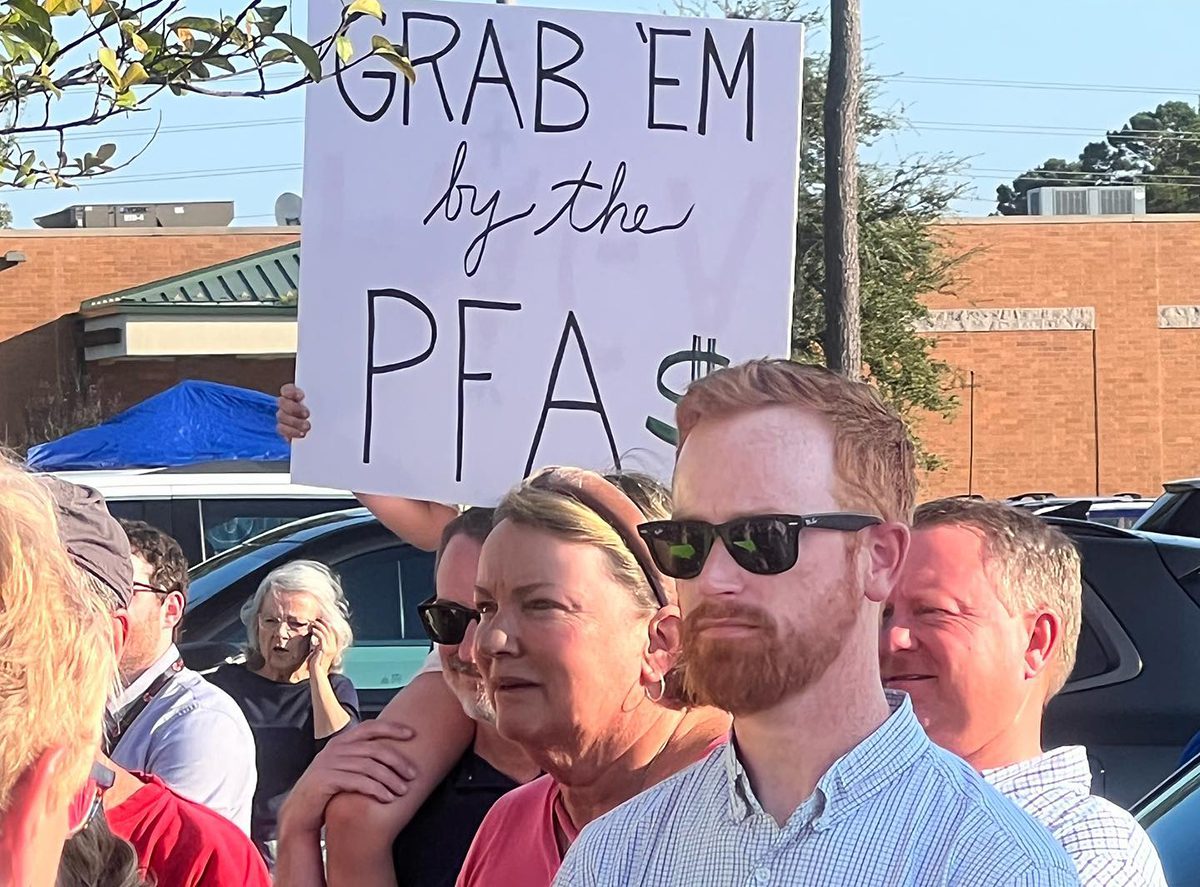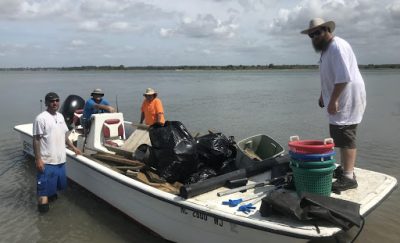
WILMINGTON – Commercial fishing crews earlier this year collected more than 200 tons of marine debris – the weight of about 80 midsized cars — from along 42 miles of central and southeastern North Carolina coastline as part of a Hurricane Florence marine debris recovery project.
The North Carolina Coastal Federation recently presented an update to the Coastal Resources Commission on the large-scale, February-August cleanup that the federation coordinated with funding from the North Carolina General Assembly.
Supporter Spotlight
The federation worked in partnership on the effort with the state Division of Marine Fisheries, which was appropriated the $400,000 by the General Assembly as part of its post-Florence disaster bill. The contracted crews that collected the debris were made up of state standard commercial fishing license resident shellfish license holders.
“The marine debris that we pulled out of the marsh area included household trash, plastic, bottles, cans, foam pieces, fishing gear, tires, building supplies, pressure treated wood that came from docks, decking, boards and pilings. These were all very large pieces of wood that had been floated up into the marsh area,” Sarah Bodin, coastal restoration specialist with the federation and one of the project managers, told the CRC members during its meeting Sept. 18-19 at the New Hanover County Government Center.
The project was separated into phases, she explained. Phase 1 focused on light consumer debris that could be placed in trash bags, while Phase 2 focused on heavy wood debris, like pilings and decks, that had to be removed with heavy equipment.
Phase 1 included the southeast region, or Lower New River to Surf City, and the central region, or the Swansboro area. The 11-person crews collected 87.6 tons of debris, or about 175,200 pounds, over the course of 117 days.
During Phase 2 in the Swansboro area, 112.7 tons were collected over 45 days by a four- to nine-person crew using a barge, excavator and other heavy equipment.
Supporter Spotlight

Collection totals for the southeast region were 75 tons and in the central region, 125.3 tons for a total of 200.3 tons.
“We tried to hire local fishermen and women who knew the surrounding waters and had a commercial fishing license. The contractor we selected for the heavy wooden debris is a local contractor who had the required equipment needed for the job,” Bodin said following the presentation.
Ted Wilgis, biologist and coastal education coordinator for the federation’s southeast office, coordinated the cleanup in the southeast region.
“Right after the storm, we started to get a lot of reports of a lot of debris in the water,” he said during the meeting.
Wilgis said coastal residents didn’t know what to do with the marine debris because there hadn’t been as much of a focus as on land-based cleanups. Some began burning the treated lumber, “which is a pretty awful source of potential pollution,” he said.
National Oceanic and Atmospheric Administration aerial imagery of the coast from Brunswick County to Harkers Island provided a view of the damage along the coast right after the storm.
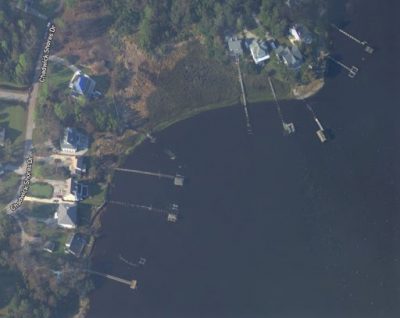
“What we saw were very large percentages of docks that were damaged or destroyed, based on that imagery,” Wilgis said. That meant that all that lumber and material was in the estuary and needed to be found and removed. A survey was also performed to help determine the amount of debris.
“Based on all this, we realized that we needed a large-scale effort to get this debris out of the water and into dumpsters and landfills,” Wilgis said.
He also explained that the most difficult work was done by the field crews. “This is very hard work,” Wilgis said, describing how the crews often went deep into the marsh to remove debris by hand.
In the field
Joe Huie, born and raised in Sneads Ferry and a commercial fisherman like his father, served as crew leader in the New River to Surf City area, or the southeast region. Around 15 years ago, Huie said he built docks and seawalls up and down the New River area.
“I’ve always seen debris accumulate after storms – anybody can see that – but early on in this project, I realized I had no clue,” he told the CRC, adding most of the debris collected couldn’t be seen from a vessel.
Everyone on his crew either lives or works in Sneads Ferry and all were shocked by the amount debris out there, he added.
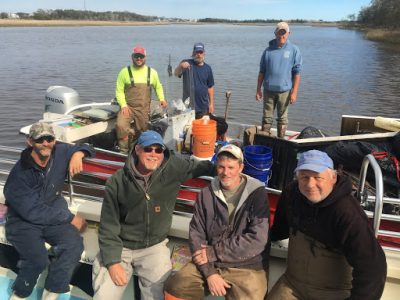
In the Surf City area, the crew found a lot of abandoned crab pots and related gear.
Huie kept daily notes of the debris they collected. He said that on a normal day, if less than 10 crab pots were recovered, he didn’t put it in the notes for that day. “In the notes alone, we got nearly 500 disposed of crab pots. We had as high as 40 crab pots in one day,” he said.
In the more densely populated areas, the crews came across “cutoffs,” or what Huie said they call the trimmings from the construction of pilings, docks, seawalls and decking boards, which appeared to have been pushed into the water rather disposed of properly.
He said crews found many cutoffs at the high-tide line. At one point, they used trash cans they found in the marsh to collect “these little triangles, 90-degree cutoffs of new construction. We would fill up trash cans every day with these little pieces of wood debris,” he said. And while that debris isn’t necessarily from the storm, it was definitely a problem that could be prevented if builders took care to properly dispose of the pieces.
During collection they also came across four dominant types of Styrofoam or Styrofoam composites: consumer debris like cups and plates; disintegrated chunks of floating docks made of Styrofoam; yards of strewn Styrofoam pieces, similar to packing peanuts, that broke out of its casing around drain pipes; and the fourth type of foam, which Huie said caught him off guard, was the Styrofoam composite material put under the siding.
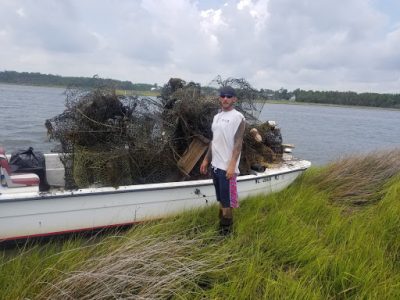
“From the first day to the last, we collected that every single day. An average 32-gallon trash bag a day at least,” he said. “Once it is under the sun … it disintegrates and is impossible to pick up. I couldn’t imagine the real amount out there in the environment.”
Huie said his crew was proud to be part of the project, which he said was needed.
Wilgis told Coastal Review Online after the meeting that the debris is a persistent problem.
He said there are things that can be done through regulations under the CRC’s purview to try to minimize debris, including better pier and dock building code recommendations and requirements for more durable structures as well as for floating docks.
There is also opportunity for outreach to homeowners and contractors on how to prepare for storms, such as removing dock planks to relieve surge pressure and securing all building and construction supplies, Wilgis said.
Derelict and abandoned vessels
The CRC also heard from Paula Gillikin, who manages Rachel Carson Reserve in Beaufort and Permuda Island in Onslow County, about the agency’s work to remove derelict and abandoned vessels after Hurricane Florence. The reserves are part of a program of the Department of Environmental Quality’s Division of Coastal Management.
Gillikin explained that one of the primary, year-round management challenges for the reserve sites is consumer debris and dock sections that wash up.
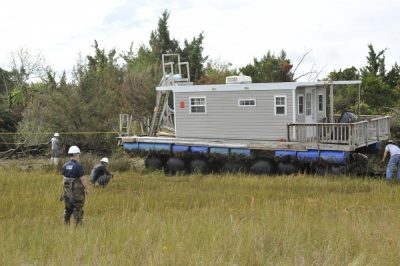
“We deal with acute debris situations especially after storms, particularly after Hurricane Florence,” she said. With the Rachel Carson Reserve located across Taylor’s Creek from downtown Beaufort, there was a lot of coastal infrastructure damage that that made its way to the reserve.
After Hurricane Florence, DCM coordinated with the Coast Guard using Federal Emergency Management Agency relief money, the Wildlife Resources Commission and the Environmental Protection Agency to address environmental hazards related to derelict and abandoned vessels.
Gillikin explained that 362 vessels were displaced during Hurricane Florence. Around 40 vessels were still in sensitive habitats and about 50 additional vessels were on less sensitive private property and other locations.
The Rachel Carson Reserve saw 11 vessels washed up after the Florence. Eight of the owners contracted with salvers to remove the vessels.
Shortly after Hurricane Florence, Beaufort commissioners passed an ordinance that addresses abandoned and derelict vessels.
“When these vessels become trash, they often remain on our property for a very long time,” Gillikin said, explaining that the reserve doesn’t have the authority to move and dispose of the vessels, even if they’re abandoned. “With Beaufort’s help, we were able to get the remaining three vessels off the reserve.”
Gillikin said that an additional $250,000 from the General Assembly and $2 million from the federal Emergency Watershed Protection Program Fund would be used to remove vessels in sensitive habitats in public trust waters and reserve properties.
In an interview after the meeting, Gillikin said that about 85 displaced vessels and other widespread debris caused by Hurricane Florence remained in the environment, including in sensitive coastal habitats.
“The state will soon receive monies to remove much of the debris and vessels. However, legal authority to remove the vessels is currently limited to jurisdictions that have abandoned vessels laws, although this could change in the coming months,” she said.
Bodin later said that the Coastal Reserve is collaborating with the federation in the abandoned and derelict vessel-removal project and Gillikin is a facilitator for the North Carolina Marine Debris Action Plan leadership team, a multiyear collaborative effort among several organizations to come up with a statewide plan to address marine debris.
Looking ahead
Federation Director Todd Miller explained to the CRC that “this housekeeping we’re doing for the coast is beyond volunteers, even if we do everything perfectly, there’s still going to be lot of debris in the environment.”
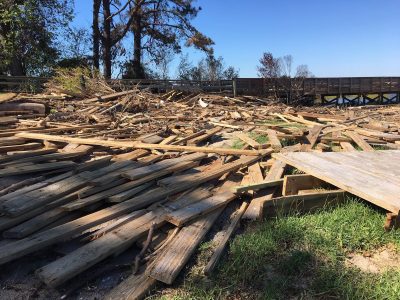
He recommended creating capacity to have these large-scale cleanups on an annual basis.
“This is not work that can be accomplished totally with volunteers. It’s tough work,” he said.
Miller told Coastal Review Online that the estimated 400,000 pounds of marine debris included a lot of chemically treated dock and construction lumber.
“The amount of material found in the marshes was astounding and illustrates the need to do a better job of designing and building coastal docks and waterfront development so that it doesn’t create these huge debris problems in the future,” Miller added.
He said that without the capacity to clean up such messes the coast would be littered with hazardous waste and hazards to public health and safety.
The project qualified the Division of Coastal Management for support from the U.S. Department of Agriculture to continue cleanup efforts, Miller said.
“In addition, the General Assembly has provided $1 million to the N.C. Wildlife Resources Commission to remove abandoned and derelict vessels, and the Coastal Federation has also received additional financial help from NOAA to continue cleanup efforts along our southeastern coast,” Miller added.
Bodin said that because several organizations were working on abandoned and derelict vessel removal, the federation was coordinating with the groups to make the process more efficient.
“For the long term, the Coastal Federation will be working on a proposal for a permanent state program,” she said.
Miller said that the combined resources should help in cleaning up the coast from the lingering effects of hurricanes Florence and Dorian.
“We hope to build an ongoing capacity to do these housekeeping projects to keep our coast the envy of the nation for years to come,” he said.





